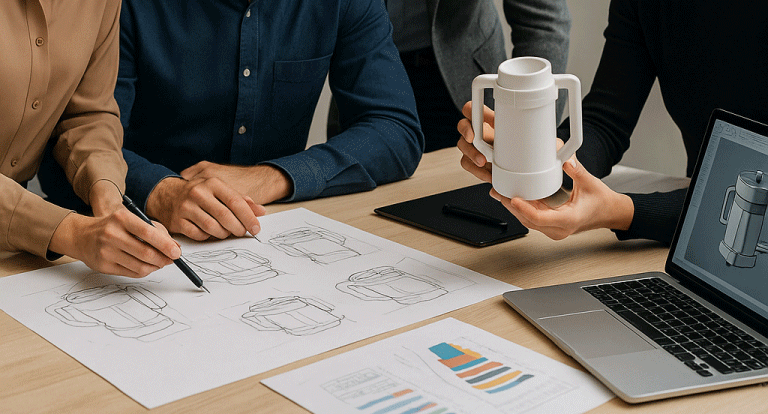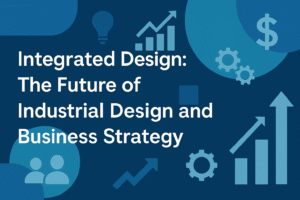
Integrated Design: The Future of Industrial Design and Business Strategy
Integrated design unites creativity, engineering, and strategy into one powerful approach. By aligning aesthetics, usability, and business goals, it delivers products that are innovative, efficient, and strategically positioned. This article explores the role of holistic product design in shaping the future of industrial design and business strategy, with insights from top design and business schools worldwide
In today’s rapidly changing business environment, companies are pressured to innovate faster, deliver sustainable solutions, and create products that stand out in competitive markets. Success no longer depends on creativity alone; it requires the seamless alignment of design, engineering, and business strategy. This is where integrated design comes in. By adopting a holistic approach, organizations can turn challenges into opportunities and ensure that every product decision supports both customer needs and long-term growth.
What Is Integrated Design?
Integrated design is a holistic process where creativity, technical expertise, and business strategy intersect. Unlike traditional models, where departments work in silos, integrated design unites multidisciplinary teams to create solutions that are innovative, manufacturable, and strategically aligned.
According to Harvard Business Review:
“Design must be treated not as decoration but as a strategic function embedded within organizations. Companies that integrate design into their operations outperform their peers in revenue growth and shareholder value.”
This proves that integrated design is more than methodology—it is a business advantage.
Additionally, a Harvard study on organizational design warns that only 10% of companies successfully align strategy with structure—underscoring the business risks of treating design as isolated or cosmetic.
Historical Roots of Holistic Product Design
The concept of holistic product design can be traced back to the Ulm School of Design (HfG Ulm) in Germany during the 1950s. The Ulm model emphasized systems thinking, sociology, and technology alongside aesthetics. Designers were trained as integrators—balancing usability, production efficiency, and brand identity. This legacy is central to today’s conversations about holistic product design, which seeks to unify every layer of product development from the sketchbook to the boardroom.
Why Integrated Design Matters for Business Strategy
Integrated design is not just a way to make products better; it is a design strategy for business.
1. Boosting Innovation and Time-to-Market
Cross-functional collaboration accelerates creativity. Instead of departments handing work off sequentially, teams iterate together. This reduces bottlenecks and helps companies launch innovative products faster.
2. Reducing Costs and Risks
When design decisions include manufacturing feasibility and user testing early, errors are identified before mass production. According to Carnegie Mellon University’s Integrated Innovation Institute, blending engineering and business with design reduces costly rework and increases market viability.
3. Aligning Product Experience with Brand Promise
A well-designed product communicates the company’s values. Integrated design ensures that brand identity is embedded in both functionality and aesthetics, strengthening customer loyalty.
4. Enabling Organizational Agility
Research from Harvard shows that only 10% of firms successfully align organizational structure with strategy. Integrated design provides a framework where business units work in harmony, making organizations more agile in facing disruption.
Leading Academic Perspectives
Harvard Business School
HBS scholars argue that design should be elevated to the executive level, with roles like Chief Design Officer ensuring that creativity is tied to strategy (HBR, 2015). Firms that invest in design as strategy see measurable improvements in customer satisfaction and shareholder returns.
Aalto University – International Design Business Management (IDBM)
Aalto’s IDBM program exemplifies the integration of design, business, and technology. Students learn to work across disciplines to manage complexity and lead innovation, preparing them for leadership roles in multinational corporations.
Carnegie Mellon University – Integrated Innovation Institute
CMU’s institute demonstrates how engineering, business, and design collaboration produces market-ready products. Their graduates are trained to approach product design holistically—solving user problems while ensuring technical and financial feasibility.
National University of Singapore – Master of Integrated Design
NUS offers programs that prepare designers for strategic leadership, emphasizing social innovation and sustainable business practices. This global shift shows integrated design is not a trend but the foundation of future-ready organizations.
Integrated Design vs. Traditional Product Design
Traditional product design often separates creative, technical, and strategic work:
- Designers focus on aesthetics.
- Engineers optimize technical performance.
- Managers look at costs and market positioning.
The result? Misalignment, delays, and higher costs.
By contrast, integrated design brings all stakeholders together early. Decisions about usability, materials, and branding are made collaboratively, producing products that are feasible, functional, and aligned with business goals.
Integrated Design in Practice: ABYN’s Approach
At ABYN Industrial Design and Production Studio, we apply integrated design principles in every project:
- Collaborative workflows → Our designers, engineers, and strategists co-create from day one.
- Alignment with business goals → Design decisions are mapped directly to market strategy and brand positioning.
- Prototype-driven experimentation → Rapid prototyping ensures we test ideas early, saving time and costs.
- Sustainable design focus → We prioritize eco-friendly solutions, aligning with modern consumer and regulatory demands.
This approach ensures our clients’ products are not only visually compelling but also viable, efficient, and profitable.
Case Examples and Real-World Validation
Design Thinking as a Foundation
Tim Brown’s influential work on Design Thinking highlights how integrating user insight, technical feasibility, and business viability creates breakthrough innovations. Integrated design builds on this foundation, scaling it to entire organizations. As Investopedia notes, holistic marketing integrates all business functions to strengthen brand value. Similarly, integrated design connects every stage of product creation, delivering consistent user and brand experiences.
Challenges of Adopting Integrated Design
While the benefits are clear, companies may face challenges:
- Cultural resistance → Teams unused to collaboration may prefer silos.
- Skill gaps → Not all designers are trained to think strategically.
- Resource demands → Integrated design requires upfront investment in cross-functional training and tools.
Yet, the long-term ROI outweighs these hurdles. Companies that successfully adopt integrated design report faster innovation cycles, stronger differentiation, and sustainable growth.
The Future of Industrial Design and Business Strategy
Looking ahead, integrated design will be essential as industries embrace AI, IoT, and sustainability. Products will no longer be judged only by performance but by how seamlessly they fit into ecosystems of use, brand narratives, and global sustainability goals.
Leading firms already see design as their competitive advantage. As Harvard Business Review concluded, design-led companies outperform the S&P 500 by over 200% in value growth. This isn’t coincidence—it’s proof that holistic product design and design strategy for business are future imperatives.
Conclusion: Designed to Win
Integrated design is not simply about creating beautiful objects. It is about ensuring every design choice—from sketch to production—supports business goals, customer needs, and societal values.
At ABYN Studio, we believe that design is business. Our integrated approach transforms ideas into market-ready products that are functional, manufacturable, and strategically aligned.
Ready to elevate your strategy with integrated design? Partner with ABYN and shape the future of your business today.
